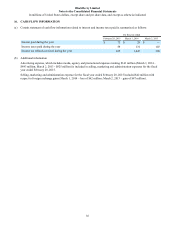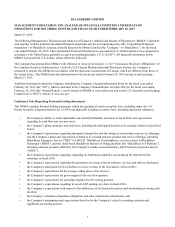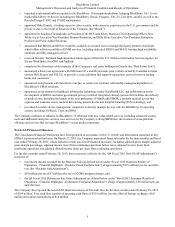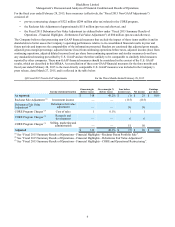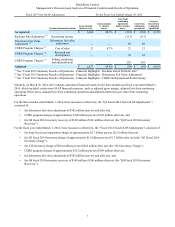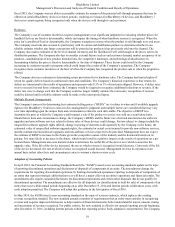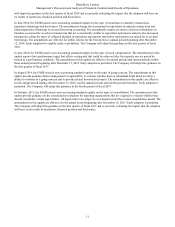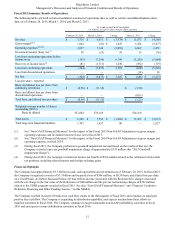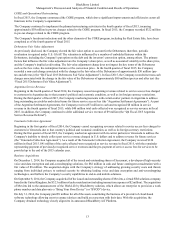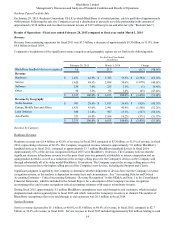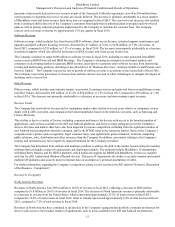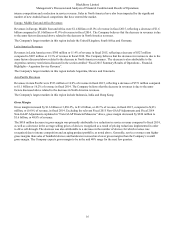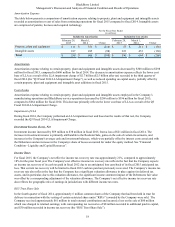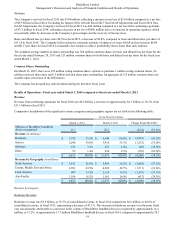Blackberry 2015 Annual Report Download - page 120
Download and view the complete annual report
Please find page 120 of the 2015 Blackberry annual report below. You can navigate through the pages in the report by either clicking on the pages listed below, or by using the keyword search tool below to find specific information within the annual report.BlackBerry Limited
Management’s Discussion and Analysis of Financial Condition and Results of Operations
9
and competitive dynamics continue to be challenging to the Company's business and the Company cannot be certain of the
duration of these conditions and their potential impact on the Company's future financial results and cash flows. A continued
decline in the Company's performance, the Company's market capitalization and future changes to the Company's assumptions
and estimates used in the LLA impairment test, particularly the expected future cash flows, remaining useful life of the primary
asset and terminal value of the asset group, may result in further impairment charges in future periods of some or all of the
assets on the Company's balance sheet. Although it does not affect the Company's cash flow, an impairment charge to earnings
has the effect of decreasing the Company's earnings or increasing the Company's losses, as the case may be. The Company's
share price could also be adversely affected by the Company's recorded LLA impairment charges.
The Company used various valuation techniques to determine the fair values of its assets to measure and allocate impairment.
Techniques related to real estate, capital equipment and intangible assets included the direct capitalization method, market
comparable transactions, the replacement cost method, discounted cash flow analysis, as well as the relief from royalty and
excess earnings valuation methods. Determining valuations using these valuation techniques requires significant judgment and
assumptions by management. Different judgments could yield different results.
Inventory and Inventory Purchase Commitments
The Company’s policy for the valuation of inventory, including the determination of obsolete or excess inventory, requires
management to estimate the future demand for the Company’s products. Inventory purchases and purchase commitments are
based upon such forecasts of future demand and scheduled rollout and life cycles of new products. The business environment in
which the Company operates is subject to rapid changes in technology and customer demand. The Company performs an
assessment of inventory during each reporting period, which includes a review of, among other factors, demand requirements,
component part purchase commitments of the Company and certain key suppliers, product life cycle and development plans,
component cost trends, product pricing and quality issues. If customer demand subsequently differs from the Company’s
forecasts, requirements for inventory write-offs that differ from the Company’s estimates could become necessary. If
management believes that demand no longer allows the Company to sell inventories above cost or at all, such inventory is
written down to net realizable value or excess inventory is written off. Significant judgment was required in calculating the
inventory charges, which involved forecasting future demand and the associated pricing at which the Company can realize the
carrying value of its inventory.
Valuation Allowance Against Deferred Tax Assets
The Company regularly assesses the need for a valuation allowance against its deferred tax assets. A valuation allowance is
required for deferred tax assets if it is more likely than not that all or some portion of the asset will not be realized. All available
evidence, both positive and negative, that may affect the realization of deferred tax assets must be identified and considered in
determining the appropriate amount of the valuation allowance. Additionally, for interim periods, the estimated annual effective
tax rate should include the valuation allowance for current year changes in temporary differences and losses or income arising
during the year. For interim periods, the Company needs to consider the valuation allowance that it expects to recognize at the
end of the fiscal year as part of the estimated annual effective tax rate. During interim quarters, the Company uses estimates
including pre-tax results and ending position of temporary differences as at the end of the fiscal year to estimate the valuation
allowance that it expects to recognize at the end of the fiscal year. This accounting treatment has no effect on the Company’s
actual ability to utilize deferred tax assets to reduce future cash tax payments. Different judgments could yield different
results. See “Results of Operations - Three months ended February 28, 2015 compared to three months ended March 1, 2014 -
Income Taxes”.
Assets Held for Sale
The Company applies judgment in determining whether the criteria for reclassifying assets as held for sale are met, including
the assessment of sale leaseback arrangements included in the plan to sell. Further, in determining fair values less costs to sell,
the Company utilizes third party appraisals, based on discounted cash flow or market comparable valuation approaches. The
Company estimates costs to sell based on historical costs incurred for similar transactions. Should any of the estimates change,
or if the actual proceeds of disposal differ from the estimate of fair value, it could have a material impact on earnings.
Revenue Recognition
Significant judgment is applied by the Company to determine whether shipments of devices have met the Company’s revenue
recognition criteria, as the analysis is dependent on many facts and circumstances. During fiscal 2014, the Company shipped
devices to its carrier and distributor partners to support new and continuing product launches and meet expected levels of end
customer demand. However, the sell-through levels for BlackBerry 10 devices decreased during fiscal 2014, causing the
number of BlackBerry 10 devices in the channel to increase above the Company's expectations. In order to improve sell-
through levels and stimulate global demand for BlackBerry 10 devices, the Company continued to execute on sell-through
programs and reduced the price on new shipments of BlackBerry 10 smartphones during fiscal 2014 and fiscal 2015. During



